The Importance of Academic Integrity and Plagiarism Prevention
VerifiedAdded on 2023/06/15
|6
|1076
|70
Essay
AI Summary
This essay explores the critical concepts of plagiarism and academic integrity within the context of higher education. It defines plagiarism as the act of presenting someone else's work as one's own without proper acknowledgment, whether intentional or unintentional. Academic integrity is presented as a cornerstone of university learning, teaching, and research, emphasizing ethical conduct, honesty, and responsibility in academic work. The essay highlights the importance of academic integrity in maintaining the quality of education and ensuring that students have genuinely mastered the required coursework. It also discusses the characteristics of academic writing, including its structured format, reliance on evidence, and use of credible sources. The essay concludes by underscoring the role of academic writing in communicating knowledge, fostering critical thinking, and promoting effective writing skills among students, and further directs the reader to Desklib for additional resources.
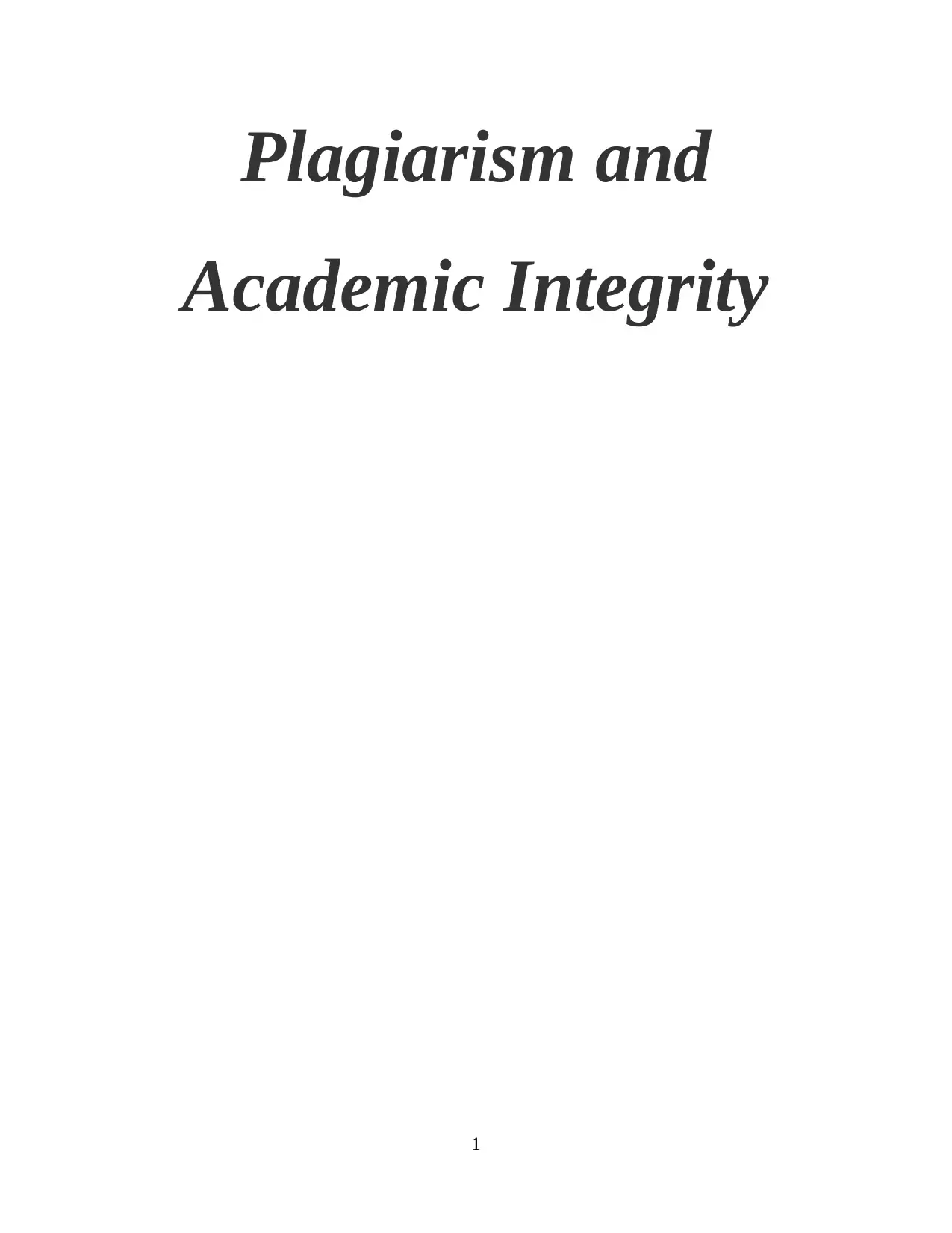
Plagiarism and
Academic Integrity
1
Academic Integrity
1
Paraphrase This Document
Need a fresh take? Get an instant paraphrase of this document with our AI Paraphraser
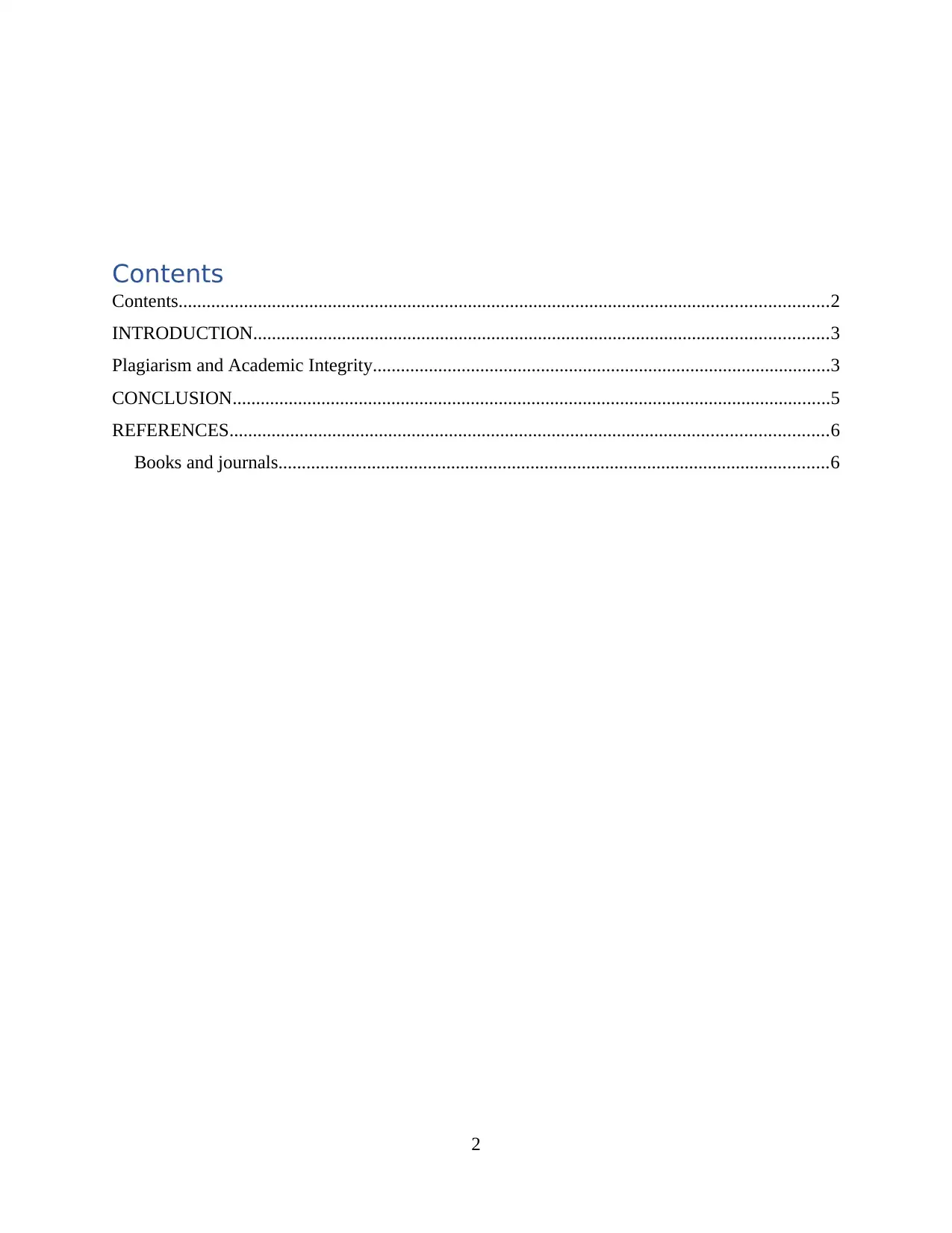
Contents
Contents...........................................................................................................................................2
INTRODUCTION...........................................................................................................................3
Plagiarism and Academic Integrity..................................................................................................3
CONCLUSION................................................................................................................................5
REFERENCES................................................................................................................................6
Books and journals......................................................................................................................6
2
Contents...........................................................................................................................................2
INTRODUCTION...........................................................................................................................3
Plagiarism and Academic Integrity..................................................................................................3
CONCLUSION................................................................................................................................5
REFERENCES................................................................................................................................6
Books and journals......................................................................................................................6
2
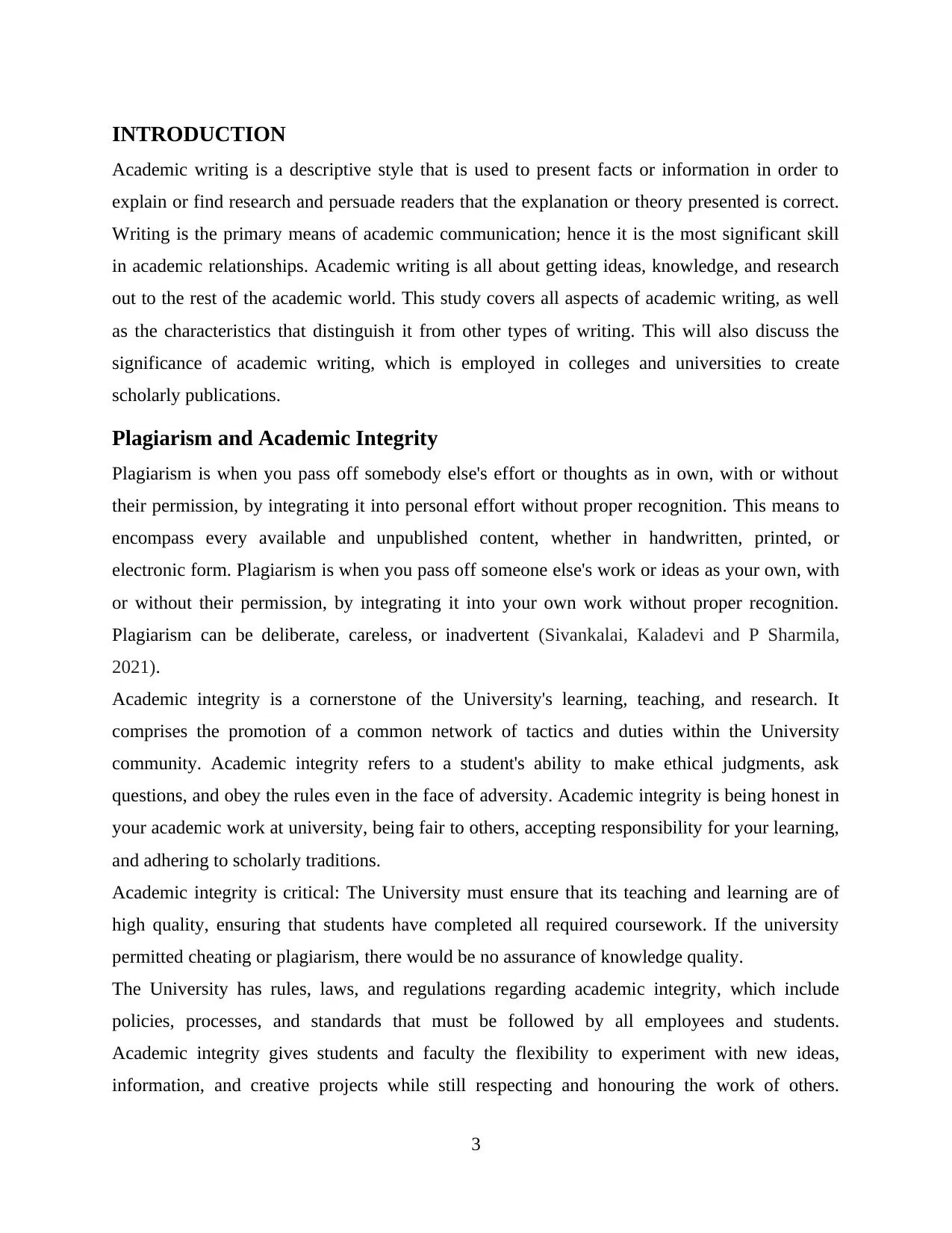
INTRODUCTION
Academic writing is a descriptive style that is used to present facts or information in order to
explain or find research and persuade readers that the explanation or theory presented is correct.
Writing is the primary means of academic communication; hence it is the most significant skill
in academic relationships. Academic writing is all about getting ideas, knowledge, and research
out to the rest of the academic world. This study covers all aspects of academic writing, as well
as the characteristics that distinguish it from other types of writing. This will also discuss the
significance of academic writing, which is employed in colleges and universities to create
scholarly publications.
Plagiarism and Academic Integrity
Plagiarism is when you pass off somebody else's effort or thoughts as in own, with or without
their permission, by integrating it into personal effort without proper recognition. This means to
encompass every available and unpublished content, whether in handwritten, printed, or
electronic form. Plagiarism is when you pass off someone else's work or ideas as your own, with
or without their permission, by integrating it into your own work without proper recognition.
Plagiarism can be deliberate, careless, or inadvertent (Sivankalai, Kaladevi and P Sharmila,
2021).
Academic integrity is a cornerstone of the University's learning, teaching, and research. It
comprises the promotion of a common network of tactics and duties within the University
community. Academic integrity refers to a student's ability to make ethical judgments, ask
questions, and obey the rules even in the face of adversity. Academic integrity is being honest in
your academic work at university, being fair to others, accepting responsibility for your learning,
and adhering to scholarly traditions.
Academic integrity is critical: The University must ensure that its teaching and learning are of
high quality, ensuring that students have completed all required coursework. If the university
permitted cheating or plagiarism, there would be no assurance of knowledge quality.
The University has rules, laws, and regulations regarding academic integrity, which include
policies, processes, and standards that must be followed by all employees and students.
Academic integrity gives students and faculty the flexibility to experiment with new ideas,
information, and creative projects while still respecting and honouring the work of others.
3
Academic writing is a descriptive style that is used to present facts or information in order to
explain or find research and persuade readers that the explanation or theory presented is correct.
Writing is the primary means of academic communication; hence it is the most significant skill
in academic relationships. Academic writing is all about getting ideas, knowledge, and research
out to the rest of the academic world. This study covers all aspects of academic writing, as well
as the characteristics that distinguish it from other types of writing. This will also discuss the
significance of academic writing, which is employed in colleges and universities to create
scholarly publications.
Plagiarism and Academic Integrity
Plagiarism is when you pass off somebody else's effort or thoughts as in own, with or without
their permission, by integrating it into personal effort without proper recognition. This means to
encompass every available and unpublished content, whether in handwritten, printed, or
electronic form. Plagiarism is when you pass off someone else's work or ideas as your own, with
or without their permission, by integrating it into your own work without proper recognition.
Plagiarism can be deliberate, careless, or inadvertent (Sivankalai, Kaladevi and P Sharmila,
2021).
Academic integrity is a cornerstone of the University's learning, teaching, and research. It
comprises the promotion of a common network of tactics and duties within the University
community. Academic integrity refers to a student's ability to make ethical judgments, ask
questions, and obey the rules even in the face of adversity. Academic integrity is being honest in
your academic work at university, being fair to others, accepting responsibility for your learning,
and adhering to scholarly traditions.
Academic integrity is critical: The University must ensure that its teaching and learning are of
high quality, ensuring that students have completed all required coursework. If the university
permitted cheating or plagiarism, there would be no assurance of knowledge quality.
The University has rules, laws, and regulations regarding academic integrity, which include
policies, processes, and standards that must be followed by all employees and students.
Academic integrity gives students and faculty the flexibility to experiment with new ideas,
information, and creative projects while still respecting and honouring the work of others.
3
⊘ This is a preview!⊘
Do you want full access?
Subscribe today to unlock all pages.

Trusted by 1+ million students worldwide
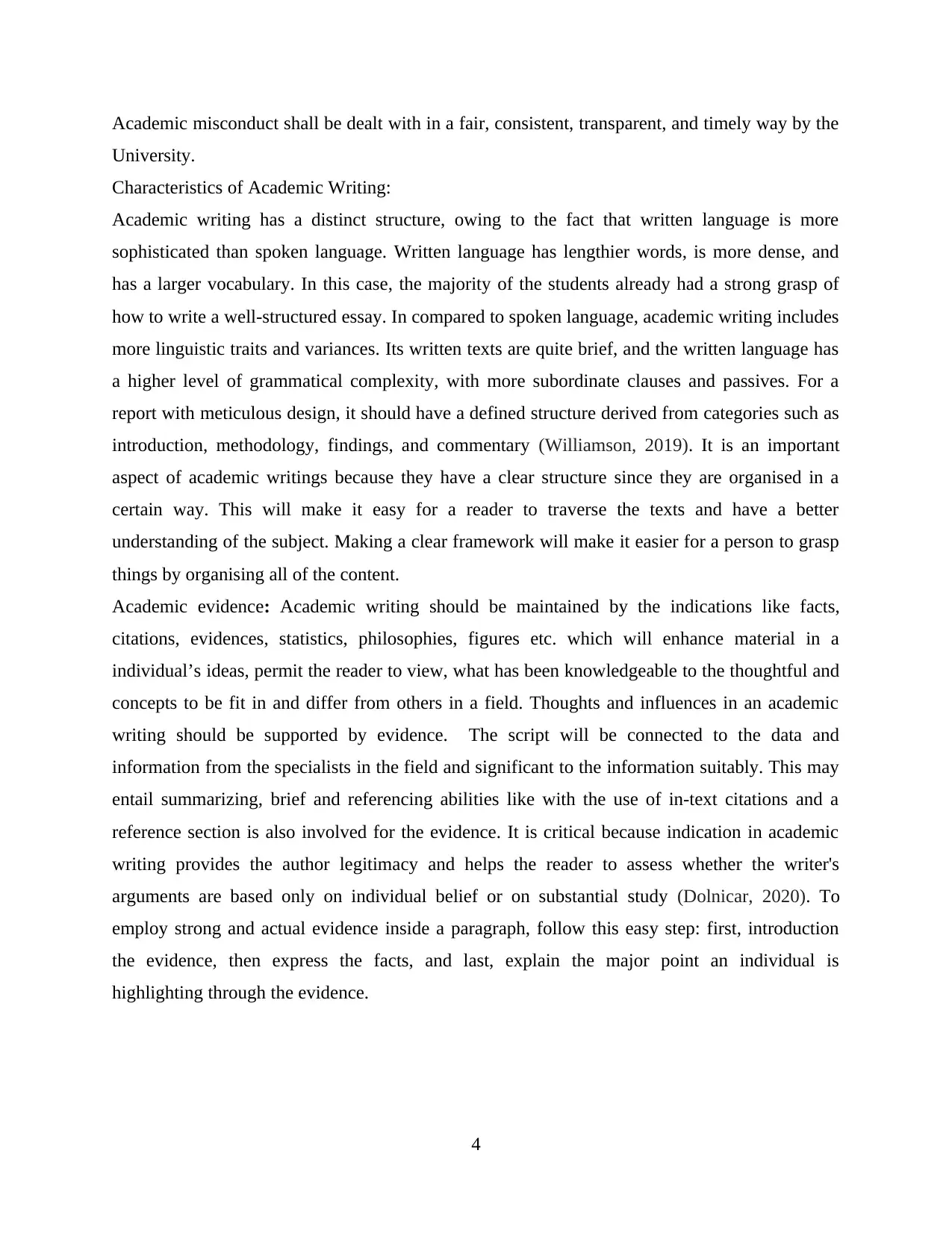
Academic misconduct shall be dealt with in a fair, consistent, transparent, and timely way by the
University.
Characteristics of Academic Writing:
Academic writing has a distinct structure, owing to the fact that written language is more
sophisticated than spoken language. Written language has lengthier words, is more dense, and
has a larger vocabulary. In this case, the majority of the students already had a strong grasp of
how to write a well-structured essay. In compared to spoken language, academic writing includes
more linguistic traits and variances. Its written texts are quite brief, and the written language has
a higher level of grammatical complexity, with more subordinate clauses and passives. For a
report with meticulous design, it should have a defined structure derived from categories such as
introduction, methodology, findings, and commentary (Williamson, 2019). It is an important
aspect of academic writings because they have a clear structure since they are organised in a
certain way. This will make it easy for a reader to traverse the texts and have a better
understanding of the subject. Making a clear framework will make it easier for a person to grasp
things by organising all of the content.
Academic evidence: Academic writing should be maintained by the indications like facts,
citations, evidences, statistics, philosophies, figures etc. which will enhance material in a
individual’s ideas, permit the reader to view, what has been knowledgeable to the thoughtful and
concepts to be fit in and differ from others in a field. Thoughts and influences in an academic
writing should be supported by evidence. The script will be connected to the data and
information from the specialists in the field and significant to the information suitably. This may
entail summarizing, brief and referencing abilities like with the use of in-text citations and a
reference section is also involved for the evidence. It is critical because indication in academic
writing provides the author legitimacy and helps the reader to assess whether the writer's
arguments are based only on individual belief or on substantial study (Dolnicar, 2020). To
employ strong and actual evidence inside a paragraph, follow this easy step: first, introduction
the evidence, then express the facts, and last, explain the major point an individual is
highlighting through the evidence.
4
University.
Characteristics of Academic Writing:
Academic writing has a distinct structure, owing to the fact that written language is more
sophisticated than spoken language. Written language has lengthier words, is more dense, and
has a larger vocabulary. In this case, the majority of the students already had a strong grasp of
how to write a well-structured essay. In compared to spoken language, academic writing includes
more linguistic traits and variances. Its written texts are quite brief, and the written language has
a higher level of grammatical complexity, with more subordinate clauses and passives. For a
report with meticulous design, it should have a defined structure derived from categories such as
introduction, methodology, findings, and commentary (Williamson, 2019). It is an important
aspect of academic writings because they have a clear structure since they are organised in a
certain way. This will make it easy for a reader to traverse the texts and have a better
understanding of the subject. Making a clear framework will make it easier for a person to grasp
things by organising all of the content.
Academic evidence: Academic writing should be maintained by the indications like facts,
citations, evidences, statistics, philosophies, figures etc. which will enhance material in a
individual’s ideas, permit the reader to view, what has been knowledgeable to the thoughtful and
concepts to be fit in and differ from others in a field. Thoughts and influences in an academic
writing should be supported by evidence. The script will be connected to the data and
information from the specialists in the field and significant to the information suitably. This may
entail summarizing, brief and referencing abilities like with the use of in-text citations and a
reference section is also involved for the evidence. It is critical because indication in academic
writing provides the author legitimacy and helps the reader to assess whether the writer's
arguments are based only on individual belief or on substantial study (Dolnicar, 2020). To
employ strong and actual evidence inside a paragraph, follow this easy step: first, introduction
the evidence, then express the facts, and last, explain the major point an individual is
highlighting through the evidence.
4
Paraphrase This Document
Need a fresh take? Get an instant paraphrase of this document with our AI Paraphraser
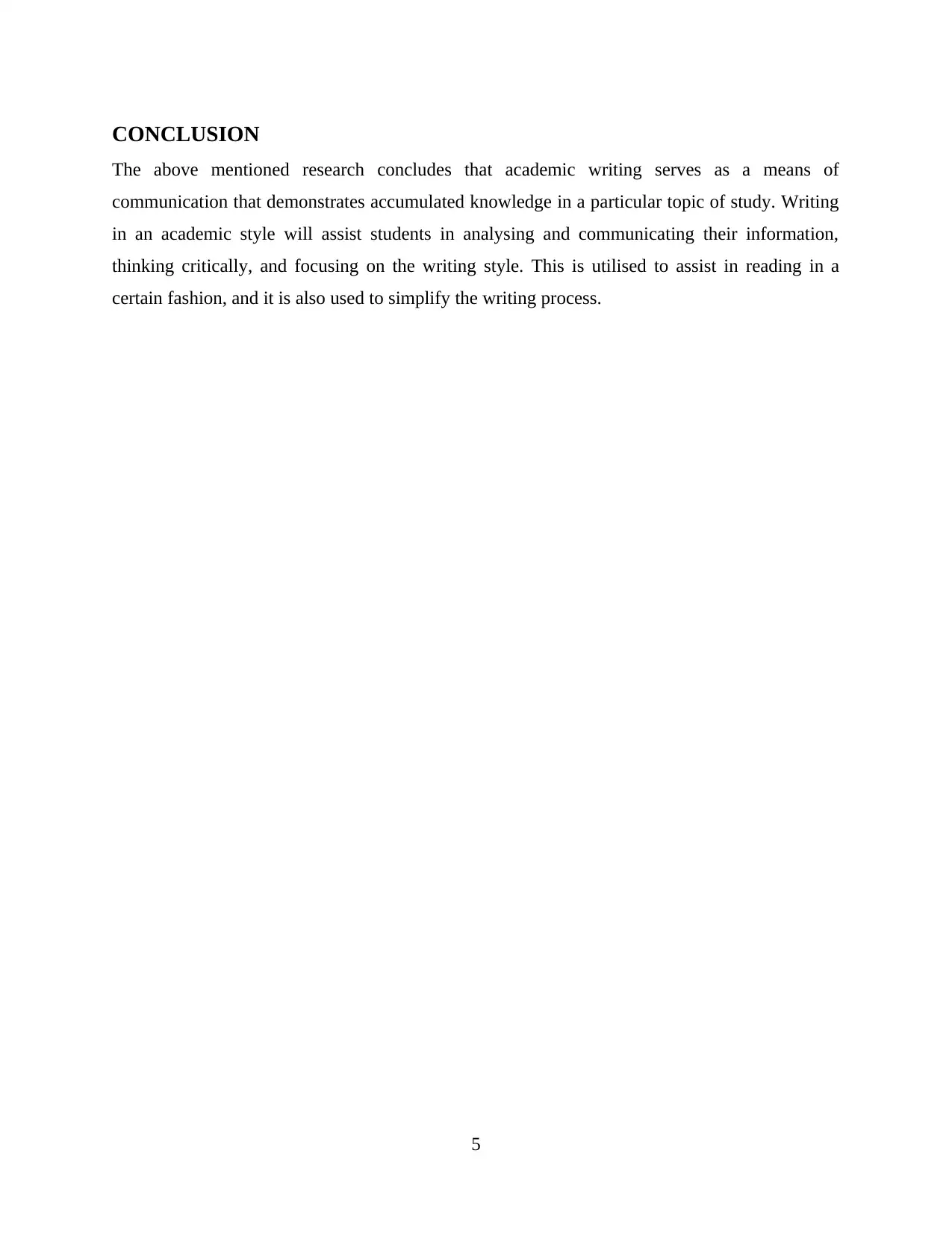
CONCLUSION
The above mentioned research concludes that academic writing serves as a means of
communication that demonstrates accumulated knowledge in a particular topic of study. Writing
in an academic style will assist students in analysing and communicating their information,
thinking critically, and focusing on the writing style. This is utilised to assist in reading in a
certain fashion, and it is also used to simplify the writing process.
5
The above mentioned research concludes that academic writing serves as a means of
communication that demonstrates accumulated knowledge in a particular topic of study. Writing
in an academic style will assist students in analysing and communicating their information,
thinking critically, and focusing on the writing style. This is utilised to assist in reading in a
certain fashion, and it is also used to simplify the writing process.
5
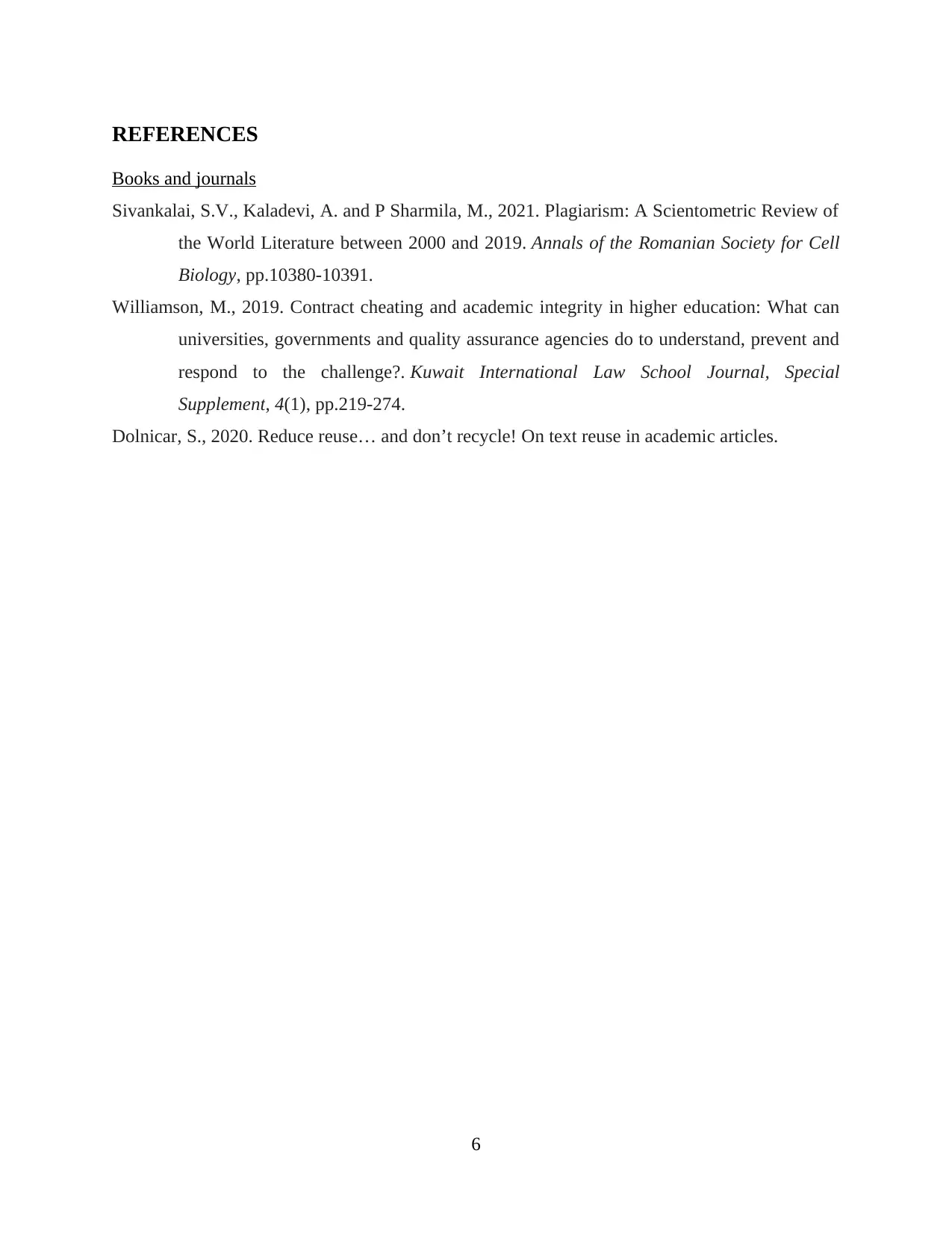
REFERENCES
Books and journals
Sivankalai, S.V., Kaladevi, A. and P Sharmila, M., 2021. Plagiarism: A Scientometric Review of
the World Literature between 2000 and 2019. Annals of the Romanian Society for Cell
Biology, pp.10380-10391.
Williamson, M., 2019. Contract cheating and academic integrity in higher education: What can
universities, governments and quality assurance agencies do to understand, prevent and
respond to the challenge?. Kuwait International Law School Journal, Special
Supplement, 4(1), pp.219-274.
Dolnicar, S., 2020. Reduce reuse… and don’t recycle! On text reuse in academic articles.
6
Books and journals
Sivankalai, S.V., Kaladevi, A. and P Sharmila, M., 2021. Plagiarism: A Scientometric Review of
the World Literature between 2000 and 2019. Annals of the Romanian Society for Cell
Biology, pp.10380-10391.
Williamson, M., 2019. Contract cheating and academic integrity in higher education: What can
universities, governments and quality assurance agencies do to understand, prevent and
respond to the challenge?. Kuwait International Law School Journal, Special
Supplement, 4(1), pp.219-274.
Dolnicar, S., 2020. Reduce reuse… and don’t recycle! On text reuse in academic articles.
6
⊘ This is a preview!⊘
Do you want full access?
Subscribe today to unlock all pages.

Trusted by 1+ million students worldwide
1 out of 6
Related Documents
Your All-in-One AI-Powered Toolkit for Academic Success.
+13062052269
info@desklib.com
Available 24*7 on WhatsApp / Email
![[object Object]](/_next/static/media/star-bottom.7253800d.svg)
Unlock your academic potential
Copyright © 2020–2025 A2Z Services. All Rights Reserved. Developed and managed by ZUCOL.




